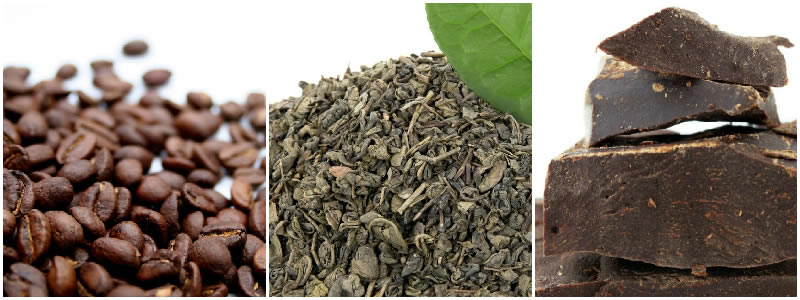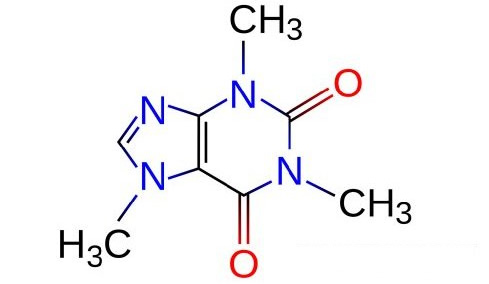Caffeine: Facts, Usage, and Side Effects
Caffeine is the most widely used psychoactive substance on the planet. Here’s an in-depth look at this drug and how it interacts with the human body.

Caffeine is a naturally occurring compound found in plant species predominantly growing in the Tropic or Sub-Tropic regions of the world. Plants use caffeine as a natural pesticide since it is toxic to insects and other pests.
However, caffeine in small quantities has therapeutic benefits in some mammals. Early human civilizations discovered that consuming plants containing caffeine offered stimulating effects and these plants even were considered sacred in some cases.
Human exploration and trade of tea and coffee soon caused caffeine use to be spread throughout the world and today greater than 80% of the world’s population uses caffeine in some form or another.
28 Plants that Contain Caffeine
| Coffee Coffea arabica |
Coffee Coffea canephora Robusta |
Coffee Coffea liberica |
Coffee Coffea canephora Guarini |
| Coffee Coffea dewevrei |
Coffee Coffea eugenioides |
Coffee Coffea salvatrix |
Coffee Coffea racemosa |
| Coffee Coffea kianjavatensis |
Cola nitide | Cola acuminate | Huito Jagua |
| Cocoa Theobroma cacao |
Cocoa Camellia ptilophylla |
Cocoa Camellia irrawadiensis |
Tea Camellia sinensis |
| Kucha Camellia assamica |
Camellia taliensis | Camelia kissi | Yerba Mate |
| Yaupon Cassina |
Guayusa | Guarana Paulliania cupana |
Yoco Paulliniayoco |
| Té o’ maté | Species of lemon trees (flowers) |
Species of orange trees (flowers) |
Species of grapefruit trees (flowers) |
Table sources: 1,2,3
Although it is often stated that 60 to 100 plant species contain caffeine in nature it is a bit difficult to find specific plants mentioned or researched other than what’s in the table above.
Botanists are likely counting many more of the subspecies and variations of the plants listed above.
Chemical Structure
Caffeine is an alkaloid, which means that it contains mostly nitrogen atoms. Morphine and nicotine are also common alkaloids.
Chemically it looks like this.

Pure caffeine is also known as trimethylxanthine and is highly water soluble. It has a melting point of 238 °C (460 °F) and caffeine has no odor but tastes very bitter.4
Caffeine’s Interaction with The Human Body
Caffeine is metabolized by the liver and broken down into theophylline, theobromine, and paraxanthine. A 200 mg dose of caffeine would take about 40 hours to be completely metabolized based on the average caffeine half-life of 5-6 hours.
However, the greatest perceived effects from the caffeine are experienced during the first 4-6 hours after consumption.
Factors that Influence Metabolism
- Caffeine sensitivity: This is based on your genes, which affect how well you can break down and process caffeine.
- Caffeine Tolerance: This develops over time as your body adapts to better process and deal with the drug.
- Drug interactions: Certain drugs and foods can hinder caffeine metabolism such as nicotine5 and large amounts of grapefruit juice6.
The Positive Effects of Caffeine
While being metabolized by the body caffeine has several well-documented positive effects on the body and its processes. Here are some of the major effects.
-
Alertness / Wakefulness
This is achieved by blocking adenosine receptors in the brain. Adenosine signals the brain that it’s time for the body to slow down and sleep. -
Pain relief
Caffeine reduces inflammation and helps to block the perception of pain in the brain.7 -
Endurance
Caffeine is believed to influence the way muscles utilize glycogen allowing them to function longer before fatigue sets in.8 -
Motivation / Productivity
Caffeine causes dopamine levels to increase, which produces a positive state of mind.9 -
Neurological conditions
Caffeine is believed to help prevent or delay Alzheimer’s disease, and Parkinson’s Disease10 as well as treat some types of hyperactivity disorders.11
The Negative Effects
While caffeine can offer a person benefits, it also comes with its share of negative effects, which vary by dose and by a person’s tolerance and sensitivity level.
-
Insomnia
Consuming caffeine too late in the day can interfere with getting to sleep and staying asleep that evening. -
Jitters
In some people, caffeine causes moderate to severe shaking of the hands. -
Addiction
Caffeine is moderately addictive and some may have trouble consuming it in moderation. -
Withdrawal headaches
Habitual caffeine users must consume close to the same amount of the drug each day or a painful withdrawal headache could result. -
Increased blood pressure
Caffeine metabolism causes stress hormones to be released which elevate a person’s blood pressure.12 -
Risk of overdose
Doses greater than 400 mg per day can elicit mild to severe caffeine overdose symptoms in adults. This can occur with much smaller doses in children or those with underlying heart conditions. -
Anxiety
Caffeine can increase anxiety especially in those diagnosed with anxiety or stress disorders.13 -
Exacerbates Heart Conditions
Since caffeine increases heart rate as well as the force in which the heart contracts, it can be dangerous for those with underlying heart conditions. However, it doesn’t appear to cause heart abnormalities.
People who are experiencing the negative side-effects of caffeine are advised to quit or cut back on their consumption.

Caffeine in Food and Beverages
Originally caffeine was only ingested through the consumption of plant parts that naturally contain caffeine, but food scientists began synthesizing caffeine as an additive for all kinds of beverages and foods.
According to our databases, there are over 800 products that contain some level of caffeine and there are many more yet to be added from all around the world.
Generally, caffeine is found in coffee and tea based beverages and products, chocolate based beverages and products, sodas, energy drinks, energy shots, and a wide range of supplements including pain relievers as well as workout supplements.
Most food governing agencies like the FDA do not require that foods containing natural ingredients like coffee or tea label that the product contains caffeine, but any added caffeine does have to be identified on the product’s label.
However, most food governing agencies do not require the amount of caffeine to be disclosed on the product’s label. Many companies have begun voluntarily disclosing how much caffeine their products contain on labels and we expect this trend to continue.
See our extensive database for the caffeine content of beverages here and the amount in foods here.
How Much is Safe?
Because caffeine is a stimulant, it should be respected and kept within safe levels for daily consumption. While the safe amount of caffeine can vary based on a person’s tolerance, sensitivity, weight, age and health history there are some established guidelines recognized by health authorities.14
- Healthy Adults: 300-400 mg a day
- Children (13-18): 100 mg per day
- Children (under twelve): None, but no more than 3 mg per Kilogram of their body weight.
- Pregnant Women: No more than 100-200 mg per day.
For a more in-depth look at daily caffeine safety amounts as well as visual representations of each amount see this article.
The Addictive Nature of Caffeine
One of the most prominent issues surrounding the use of caffeine is its addictive nature.
While caffeine still hasn’t been included in The National Institute of Drug Abuse’s Commonly Abused Drugs List it certainly does cause some level of addiction.
Recently both caffeine overdose and caffeine withdrawal were both added to the latest edition of the Diagnostic and Statistical Manual of Mental Disorders (DSM-5), but caffeine addiction has not been added as a diagnosable condition.
However, those that use caffeine and have tried to quit can attest that caffeine causes some degree of both psychological and physiological addiction.
Caffeine addiction can range from mild to severe and most of the time it is an addiction most people can live a healthy life with. This is not the case when dangerous amounts of caffeine are being consumed daily or if caffeine is consumed through sugary beverages, which are linked to obesity and type 2 diabetes.15
Use our Caffeine Addiction Diagnosis Tool to assess your level of addiction to caffeine.
Cutting back on caffeine would be recommended for anyone who begins to consume amounts exceeding what is recommended as safe or if getting enough caffeine interferes with work or daily functioning.
Human Deaths and Caffeine Consumption
Since caffeine is a toxic substance it can cause severe overdose reactions and even death if too much is consumed at one time or over a short period of time. On average the LD50 or lethal dose of caffeine for humans is 150 mg per kilogram of a person’s body weight per day.16 Our Death By Caffeine App is based on this formula.
However, the lethal amount can be much less depending on a person’s unique genetic make-up and health history. There have been several well-documented deaths associated with caffeine and in most of the cases less than the LD50 was consumed.
Deaths related to caffeine consumption, especially among teens have caused several consumer groups (as well as politicians) to call for the ban of dangerous caffeinated products. These groups are pressing for tighter restrictions on how kids can access caffeine.
The Industry
Despite the problems associated with caffeine use, don’t expect humans to quit using it anytime soon. According to the International Coffee Organization coffee alone is a 60 billion dollar industry worldwide and the energy drink/energy shot industry is worth over 13 billion in the USA alone.
There is huge money in keeping people caffeinated and consumer demand has never been greater since China is now turning on to espresso based coffee.
All of this money means that the industry has a huge influence on lawmakers and food policy, so any new regulations involving caffeinated products will likely be small. However, expect stricter caffeine labeling regulations to be issued soon most likely including caffeine amounts and safety warnings.17
Education is Paramount
Educating consumers about caffeine is the single most important factor in helping people safely use caffeine. If consumers gain knowledge about the amount of caffeine in the products they consume as well as the dangers associated with consuming too much, then consumers will be able to make educated and responsible decisions regarding caffeine consumption for themselves and any minors under their care.
Schools also should build caffeine safety education into their health curriculum, so that caffeine awareness and safety can be ingrained into our culture from an early age.
Caffeine use isn’t going stop anytime soon, so understanding how to use caffeine both safely and responsibly is crucial.

Get Help Quitting Caffeine
Reduce your caffeine intake without pain and discomfort.
Download our FREE ebookReferences
- 1. https://botanistinthekitchen.wordpress.com/2013/12/24/hollies-yerba-mate-and-the-botany-of-caffeine/
- 2. Ashihara, H., & Crozier, A. (2001). Caffeine: a well known but little mentioned compound in plant science. Trends in plant science, 6(9), 407-413. link
- 3. Ashihara, H., Sano, H., & Crozier, A. (2008). Caffeine and related purine alkaloids: biosynthesis, catabolism, function and genetic engineering. Phytochemistry, 69(4), 841-856. link
- 4. Sutor, D. J. (1958). The structures of the pyrimidines and purines. VII. The crystal structure of caffeine. Acta Crystallographica, 11(7), 453-458. link
- 5. Brown, C. R., Jacob 3rd, P., Wilson, M., & Benowitz, N. L. (1988). Changes in rate and pattern of caffeine metabolism after cigarette abstinence. Clinical pharmacology and therapeutics, 43(5), 488. link
- 6.Fuhr, U., Klittich, K. R. I. S. T. I. N. A., & Staib, A. H. (1993). Inhibitory effect of grapefruit juice and its bitter principal, naringenin, on CYP1A2 dependent metabolism of caffeine in man. British journal of clinical pharmacology, 35(4), 431-436. link
- 7. J Snel and MM Lorist, “Caffeine and Information Processing” in Pleasure and Quality of Life, ed. D. Warburton and Sherwood, Chichester: John Wiley & Sons, 1996, p. 107.
- 8. Graham, T. E. (2001). Caffeine and exercise. Sports medicine, 31(11), 785-807. link
- 9. Solinas, M., Ferré, S., You, Z. B., Karcz-Kubicha, M., Popoli, P., & Goldberg, S. R. (2002). Caffeine induces dopamine and glutamate release in the shell of the nucleus accumbens. The Journal of neuroscience, 22(15), 6321-6324. link
- 10. Ross, G. W., & Petrovitch, H. (2001). Current evidence for neuroprotective effects of nicotine and caffeine against Parkinson’s disease. Drugs & aging,18(11), 797-806. link
- 11. Wild, C. T. (1981). How to cure hyperactivity: a blueprint involving nutrition," more than a theory". Attention span advancement registry service. link
- 12. James, J. E. (2004). Critical review of dietary caffeine and blood pressure: a relationship that should be taken more seriously. Psychosomatic medicine,66(1), 63-71. link
- 13. Pané-Farré, C. A., Alius, M. G., Modeß, C., Methling, K., Blumenthal, T., & Hamm, A. O. (2014). Anxiety sensitivity and expectation of arousal differentially affect the respiratory response to caffeine. Psychopharmacology, 1-9. link
- 14. Wesensten, N. J. (2014). Legitimacy of concerns about caffeine and energy drink consumption. Nutrition reviews, 72(suppl 1), 78-86. link
- 15. Bray, G. A., & Popkin, B. M. (2014). Dietary sugar and body weight: have we reached a crisis in the epidemic of obesity and diabetes? Health be damned! Pour on the sugar. Diabetes Care, 37(4), 950-956. link
- 16. Peters, J. M. (1967). Factors affecting caffeine toxicity: a review of the literature.The Journal of Clinical Pharmacology and the Journal of New Drugs, 7(3), 131-141. link
- 17. Rosenfeld, L. S., Mihalov, J. J., Carlson, S. J., & Mattia, A. (2014). Regulatory status of caffeine in the United States. Nutrition reviews, 72(suppl 1), 23-33. link





